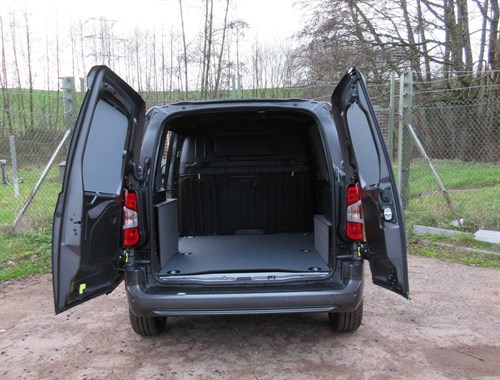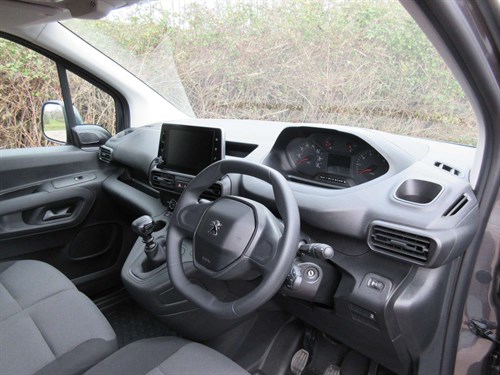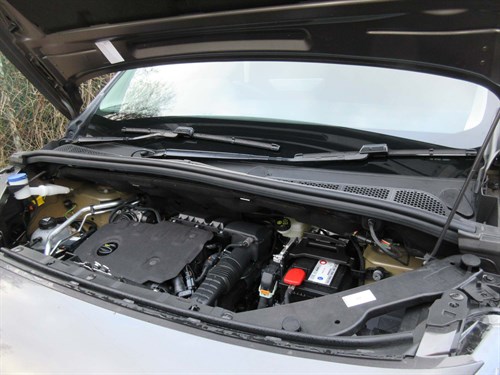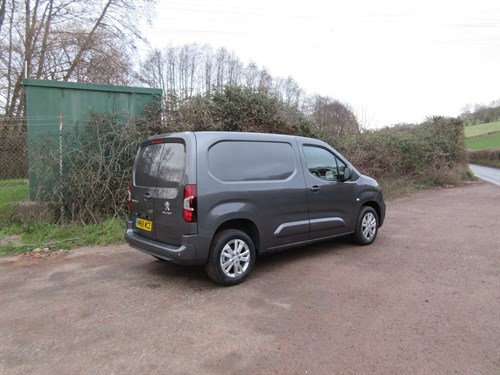As the number three player in the van market in 2018 behind Volkswagen and the all-conquering market leader Ford, Peugeot is determined to win further registrations with the all-new Partner.
To do so it will have to outsmart two in-house rivals.
Like Peugeot, both Citroen and Vauxhall are part of the PSA Group, and one suspects that neither of Peugeot’s rival brands will willingly give ground. Once again Citroen is marketing the Partner as the Berlingo while Vauxhall is selling it as the Combo, replacing a model with the same name that used a Fiat Professional platform.
All three models are front-wheel drive, and identical under the metal, but are styled and badged differently.
They are being marketed with two different wheelbases giving two different overall lengths: L1 and L2. One roof height is offered giving a load cube of either 3.3m3 or 3.8m3. Gross payload capacities extend from 667kg to 1,050kg.
The initial diesel engine offer is a 1.6-litre BlueHDi Euro6.1 producing either 75hp or 100hp or a 1.5-litre BlueHDi Euro6.2 generating 130hp and produced in conjunction with Ford. The former is married to a five-speed manual gearbox while its stablemate is mated to either a six-speed manual or an eight-speed automatic transmission. However, the 1.6-litre is on the verge of being dropped in favour of equivalent versions of the 1.5-litre.
In the pipeline for later this year is a 1.2-litre three-cylinder petrol engine with 110hp or 130hp on tap.
Battery-powered versions of the departing Partner and Berlingo will remain available until 2020, when electric variants of the new model should break cover.
The Partner’s specification walk starts at entry-level S, moves through Professional and finishes at Asphalt, a somewhat-odd choice of name.
Also available is the Grip model. Aimed at construction companies, utilities and other operations that need to venture off-road, it boasts 30mm more ground clearance plus underbody protection and Grip Control traction control.
Given that the larger Citroen Dispatch and Peugeot Expert are sold by Toyota as the Proace, it should not be too much of a surprise to learn that Toyota is planning to start marketing its own version of the Partner/Berlingo/Combo.
We opted to sample an L1 Partner in Professional trim powered by the 130hp 1.5-litre. At this stage it should be noted that the Partner, Berlingo and Combo were jointly awarded the What Van? Light Commercial of the Year Award for 2019.

Load bay
Access to the 3.3m3 cargo bay is by means of asymmetric rear doors – the narrower of the two is on the off-side – and a sliding nearside door. The back doors can be swung through 180° if you release the stays.
Six cargo tie-down points are fitted. So is a full-height steel bulkhead, which should protect the occupants of the cab if an unsecured load slides forwards under heavy braking. The gross payload capacity of this model is a smidgeon over a tonne.
A tailored cover protected our demonstrator’s cargo bed, and the sides, doors and wheel boxes were defended from minor damage by a mixture of plastic and plywood panels.
What our demonstrator did not have was the much-publicised overloading indicator, which is not yet listed as an option on the Partner in the UK.

Interior and equipment
The Partner Professional comes equipped with a three-seater cab, and we frankly cannot understand why some manufacturers insist on trying to stuff in three seats when there clearly isn’t enough room for them.
Whoever is unfortunate enough to occupy the middle seat – or attempt to – will find that they have no legroom whatsoever because of the way in which the moulding that accommodates the gear stick bulges out from the dashboard.
Installing three seats means there is no space for a floor-mounted handbrake lever. An electronic parking brake operated with a switch is fitted instead. As a safety precaution you have to put your foot firmly on the brake pedal before the parking brake can be released. Its release is accompanied by a muted whine from the rear of the vehicle.
Electric windows and electrically adjustable mirrors are installed on all Partners. Upgrading to Professional specification gets you heated exterior mirrors and the ability to fold them inwards electrically plus air-conditioning and cruise control with a variable speed limiter.
Reversing sensors are fitted to Professionals with a schematic of the vehicle shown on an 8in colour touchscreen. Standing up in the middle of the fascia like a permanently fixed tablet, it controls the digital radio, with remote controls mounted on the steering wheel. The touchscreen also plays host to Apple CarPlay, Android Auto and Mirrorlink on Professional models.
Two USB ports are fitted plus a 12V power point. Featuring a head-up display, the cab is Bluetooth-enabled.
Storage facilities include a full-width shelf above the windscreen, two pockets in each of the doors, a cubbyhole on the passenger side of the fascia with a shelf above it, plus a deep, lidded but not lockable glovebox. You will find another shelf behind the up-standing touchscreen plus cupholders at each extremity of the dashboard.
Both the steering wheel and the driver’s seat are height-adjustable and there is stowage beneath the seat.
The aforementioned centre passenger Multi-Flex seat is at least good for a couple of things. It conceals a storage compartment, and flipping the back down creates a handy desk that the driver can use to complete paperwork.
Fold down the outboard passenger seat and flip a panel in the bulkhead backwards into the cargo compartment and you have instantly created a load-through facility. It allows the Partner to accommodate extra-long lengths of timber, pipe-work and so on.
To ensure the items do not end up rolling around the cab they can be slid into what is best-described as a large, detachable sock. While it seems like a good idea on paper, it is somewhat awkward to use. One suspects it will become permanently detached after a few weeks of service.
Turning to safety, ABS, electronic stability control, electronic brakeforce distribution and emergency brake assist all come as standard along with hill-start assist.
Cruise control is installed along with a programmable speed-limiter. So is a tyre pressure monitoring system.
The Peugeot Connect SOS and Assistance button is positioned overhead next to the buttons for the courtesy lights should you need it in an emergency.
All four wheels feature disc brakes – the front ones are ventilated – and driver and passenger airbags are fitted. So are front fog lights with cornering assist if you opt for Professional specification.
Our demonstrator sat on optional 16in Taranaki alloy wheels (named after a volcano in New Zealand) shod with Michelin Energy 205/60 R16 tyres. A steel spare wheel is provided.
Electric power steering offers a 10.85m turning circle.

Engine and gearbox
Married to a six-speed manual transmission, our Partner’s four-cylinder high-pressure common-rail turbodiesel produces its maximum power at 3,750rpm. Top torque of 300Nm bites at 1,750rpm.
AdBlue is required to ensure that the engine meets the Euro 6.2 emission standard and is held in a 17-litre reservoir.
Driving
With 130hp on tap the short-wheelbase Partner is not short of performance even when laden with half a tonne of bagged gravel. A slick, quick gear-change allows the driver to make full use of the power and torque that is on offer, and the handling is dependable enough to keep you out of trouble on tight rural bends.
While the ride is fine when you have a decent amount of weight onboard, the suspension can sometimes struggle to cope with uneven surfaces when the vehicle is lightly laden. Empty or full, more effort should be made to tune out wind noise.
On the face of it the oddly shaped steering wheel (anybody out there remember the so-called Quartic – i.e. square – steering wheel fitted to the old Austin Allegro?) should make manoeuvring more difficult, but it doesn’t. In fact, the Peugeot Partner is highly manoeuvrable at low speeds – a boon if you are attempting to make a delivery in a busy city centre and trying to squeeze into a tight parking space.

Operating
Service intervals are set at 12 months/20,000 miles and the Partner is covered by a 36-month/100,000-mile warranty with no mileage limit in the first two years.
Fuel economy doesn’t appear to be an issue. We returned around 60mpg compared with an official combined figure of 64.2mpg. Stop/start is fitted, and that clearly helps.
One problem we had was the repeated triggering of the alarm – standard on Professional Partners – a few seconds after we had locked the vehicle using the key fob. We crawled all over the vehicle trying to discover what was causing it – was it a door accidentally left open or a light switched on somewhere? – but to no avail. When we contacted Peugeot we were told that it might be a wonky sensor beneath the bonnet. If it was, we couldn’t spot it.
The instrument panel regularly reminded us that Energy Economy Mode was activated. It is there to ensure that if anything in the vehicle is inadvertently left switched on then it will be turned off automatically if there is any risk that the battery will be flattened.
Side rubbing strips help protect the body from minor damage. The rubbing strips, bumpers, door handles and mirror casings were finished to match the rest of the body’s optional metallic paintwork because our test light commercial boasted the optional Look Pack.
Professional L1 1000 BlueHDi 130 S&S 6-speed manual
Price (ex VAT) £19,905
Price range (ex VAT) £16,280-£23,425
Gross payload 1,001kg
Load volume 3.3m3
Load length 1,817mm
Load width (min/max) 1,229/1,550mm
Load bay height 1,236mm
Loading height 548mm
Rear door aperture 1,241×1,196mm
Side door aperture 675×1,072mm
Gross vehicle weight 2,390kg
Braked trailer towing weight 1,200kg
Residual value 23.8%*
Cost per mile 38.1p*
Engine size/power 1,499cc, 131hp @ 3,750rpm
Torque 300Nm @ 17,50rpm
Gearbox 6-spd
Fuel economy 64.2mpg
Fuel tank 50 litres
CO2 117g/km
Warranty 3yrs/100,000mls
Service intervals 1yr/20,000mls
Insurance group 35E
Price as tested £21,075
* after 4yrs/80,000mls; source: KwikCarcost
Options fitted
16in alloy wheels £550
Metallic paint £350
Look Pack £270
Rivals
Ford Transit Connect
Price (ex VAT) £15,665-£21,765
Load volume 2.9-3.6m3
Gross payload 579-865kg
Engines 100hp 1.0 petrol, 75hp, 100hp, 120hp 1.5 diesel
Verdict: The Ford excels in pretty much every department. Its handling and performance are class-leading, fuel consumption won’t break the bank, the gear-change is one of smoothest we’ve ever seen, and the cab interior is comfortable and well laid out with lots of storage space.
Renault Kangoo/Kangoo Maxi
Price (ex VAT) £15,830-£25,700
Load volume 3.0-4.0m3
Gross payload 650-800kg
Engines 75hp, 90hp, 110hp 1.5 diesel, 44kW electric
Verdict: Now with extra range, the EV Kangoo Z.E looks set to appeal to more customers who’ll find it practical and eco-friendly. That’s not to criticise the Kangoo’s frugal diesel engines however, which are married to a user-friendly gearbox. It’s an underrated model that deserves to win more friends.
Volkswagen Caddy/Caddy Maxi
Price (ex VAT) £14,325-£24,685
Load volume 3.2-4.2m3
Gross payload 545-736kg
Engines 84hp 1.2 petrol, 102hp 1.0 petrol, 125hp 1.4 petrol, 75hp, 102hp, 150hp 2.0 diesel
Verdict: If you want a truly durable light van then it has to be this. Impressive build quality comes with exemplary diesel engines and top-notch on-the-road performance and handling. Interior and exterior styling flair is lacking, though, and more work is needed to quieten in-cab noise levels.
The Final Verdict
|
Design |
8/10 |
A well put-together package with some useful features. |
|
Cabin |
5/10 |
Lots of storage space, but three seats is too big a squeeze. |
|
Ride |
6/10 |
Can struggle on uneven surfaces when lightly loaded. |
|
Refinement |
7/10 |
In-cab noise is a little high, but the van feels well put together. |
|
Load area |
7/10 |
Solid-looking bulkhead, sufficient tie-down points, easy access. |
|
Handling/performance |
8/10 |
Former is safe and dependable; no complaints about the latter. |
|
Engine/transmission |
8/10 |
Well-matched, with a slick gear-change. |
|
Standard equipment |
8/10 |
Professional trim gets you all the goodies. |
|
Operating costs |
8/10 |
Looks fuel-efficient. Warranty/servicing seem to make sense. |
|
What Van? subjective rating |
8/10 |
A worthy winner of our 2019 LCV of the Year Award. |





